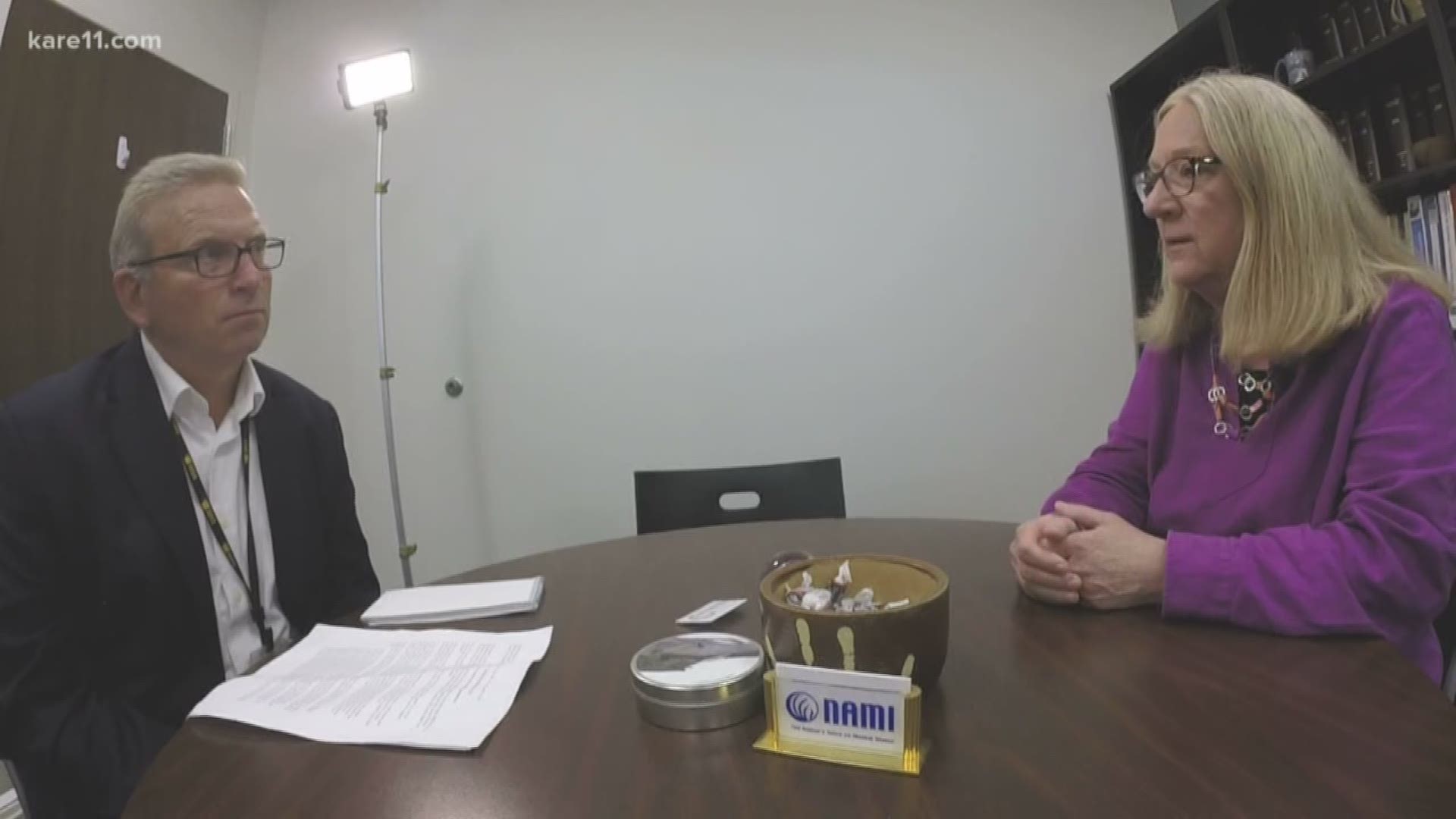MINNEAPOLIS -- The suicide deaths of celebrity chef Anthony Bourdain and fashion designer Kate Spade within the same week have sparked renewed focus on mental health, and on the larger issue of untreated mental illnesses.
It's not as simple as increasing budgets or finding a fix. The entire way of thinking about mental health treatment needs to change, according to Sue Abderholden of the National Alliance on Mental Illness, or NAMI.
"A lot of people want to say we have a broken mental health system and that’s the problem. We would actually say that problem is we never built a system," Abderholden, the executive director of the Minnesota NAMI Chapter, told KARE.
"The state hospitals were not a mental health system. They closed, and rightly so. And what didn't happen is we did not fund the community services that people needed to stay well in the community."
It was President John F. Kennedy who signed the Community Mental Health Act in 1963, which launched the move away from large institutions and toward community-based treatment. But community-based treatment has never been fully funded, and patients in crisis very often fall into gaps in the system.
"Health care systems created urgent cares, but we don’t have urgent cares that serve people with mental illness," Abderholden said.
"I know now it can take easily three months to get in to see a psychiatrist. If you have a very serious mental illness, that’s just too long."
There are mobile crisis teams, and you can find more information about how to reach them on NAMI's Crisis Resources page.
Providers strained
Payments to providers from Medicaid and some insurers haven't kept up with the actual cost of delivering care, which exacerbates an ongoing workforce shortage issue in the treatment field.
"The payment rates, particularly in Medicaid-managed care, and sometimes in private insurance is so low, that it makes it difficult to attract people to the field, in particular from culturally diverse communities," Aberholden said.
And, despite the efforts of the late Paul Wellstone and many others, treatment for long-term mental illnesses have rarely been on par with treatments of other medical conditions.
"We have people boarding in emergency rooms waiting for an inpatient psychiatric bed, and I can tell you today if those were patients having heart attacks and they were waiting for a cardiac unit, hospitals would’ve built new cardiac beds -- yesterday!" Abderholden remarked.
She said the same disparities apply to what is known as step-down care.
"If you get a new hip, your insurance company will pay for you to get rehab in a nursing home," Abderholden explained. "They won’t pay for rehab it you have schizophrenia, and you’re leaving an in-patient unit and you need residential treatment."
So, Abderholden, many of the barriers patients face are often the result of the health care system's bias against psychiatric care and patients seeking help.
"People talk a lot about stigma -- I just want to say we need to stop using that word. It’s not about stigma, it is absolutely about discrimination."
State funding
The State Dept. of Human Services in FY2017 spent $303 million on state-operated treatment centers, such as the Anoka Regional Treatment Center and the State Hospital in St. Peter. The agency also distributed $102 million in grants to community programs, including school-linked mental health services.
The Dept. of Education provides funding for behavioral health training in districts across the state, and help with anti-bullying programming in schools.
The Dept. of Corrections in 2018 has budged $9 million for mental health treatment for inmates. A request for another $2 million for the next two years wasn't funded by the legislature.
"Dollars alone doesn't help us," Abderholden said.
"We also need to know the number of people served. We need to know how quickly can you access care. Are you accessing the right care at the right time? So just using the total dollar amounts is not a way to determine whether you have a good mental health system."
Inmates on hold
The shortage of inpatient treatment options has created a challenge for county sheriffs across Minnesota who run jails. They have inmates who normally would be released, but can't be set free because they're covered by involuntary inpatient treatment order.
Hennepin County Sheriff Rich Stanek recently wrote to Gov. Mark Dayton, asking him to intervene in the case of such an inmate who's been in jail for 65 days, even though the misdemeanor charge was subsequently dismissed.
"Even if he was convicted of a misdemeanor offense that he was originally arrested for, he may serve a day or two in jail, but not 65 days, and so we’re essentially criminalizing being mentally ill," Sheriff Stanek told KARE.
"I don’t think that’s what Minnesota’s about, and that’s why I reached out to Governor Dayton and asked him to get engaged on this."
Stanek said that sheriffs pressed the issue of the shortage of inpatient mental health treatment beds with Human Services Commissioner Emily Johnson Piper recently.
"We asked her what’s stopping the State of Minnesota from doing the right thing, and providing the proper mental health services to these folks.They need treatment, not just incarceration. They didn't do anything criminally wrong."
The treatment centers are obligated to admit those who are most critically ill. Abderholden said a patient in a rural hospital in an underserved part of the state may actually have a more acute need for inpatient treatment than an inmate in a county jail in an urban area.
In the case of Hennepin County, the sheriff's office contracts with nearby Hennepin County Medical Center for a spectrum of health care services, including mental health. There was no data available Friday afternoon on how much of the HCMC jail contract goes to mental health services for inmates.

